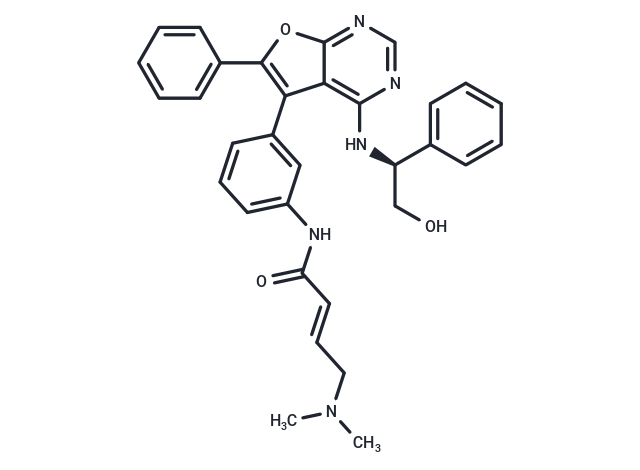Shopping Cart
- Remove All
 Your shopping cart is currently empty
Your shopping cart is currently empty

DBPR112 is an orally active furanopyrimidine-based EGFR inhibitor with IC50s of 15 nM for EGFRWT and 48 nM for EGFRL858R/T790M, capable of occupying the ATP-binding site and demonstrating significant antitumor efficacy.

| Pack Size | Price | Availability | Quantity |
|---|---|---|---|
| 1 mg | $69 | In Stock | |
| 5 mg | $173 | In Stock | |
| 10 mg | $322 | In Stock | |
| 25 mg | $520 | In Stock | |
| 50 mg | $693 | In Stock | |
| 100 mg | $954 | In Stock | |
| 1 mL x 10 mM (in DMSO) | $198 | In Stock |
| Description | DBPR112 is an orally active furanopyrimidine-based EGFR inhibitor with IC50s of 15 nM for EGFRWT and 48 nM for EGFRL858R/T790M, capable of occupying the ATP-binding site and demonstrating significant antitumor efficacy. |
| Targets&IC50 | EGFR (WT):15 nM, EGFR (L858R/T790M):48 nM |
| In vitro | DBPR112 (0.32-1000 nM; 16 hours) induces reduction of phosphorylated EGFR in a dose-dependent manner[1]. DBPR112 shows the inhibitory activity against HCC827 (CC50=25 nM), H1975 (CC50=620 nM) and A431 Cell (CC50=1.02 μM) cell lines[1]. DBPR112 occupies the ATP-binding site and interacts with surrounding residues by covalent bonding, hydrogen bonds, and hydrophobic interactions, which give it a potent inhibitory activity against WT EGFR[1]. |
| In vivo | DBPR112 administered orally at 20-50 mg/kg for 5 days per week over 2 weeks significantly reduces tumor growth in the HCC827 tumor model. Oral administration of DBPR112 at 50 mg/kg once daily for 15 days results in a mean tumor growth inhibition of 34% in the H1975 tumor model [1]. Intravenous administration of DBPR112 at 5 mg/kg in rats shows a T1/2 of 2.3 hours, a CL of 55.6 mL/min•kg, and a Vss of 8.6 L/kg [1]. |
| Molecular Weight | 533.62 |
| Formula | C32H31N5O3 |
| Cas No. | 1226549-49-0 |
| Smiles | CN(C)C\C=C\C(=O)Nc1cccc(c1)-c1c(oc2ncnc(N[C@H](CO)c3ccccc3)c12)-c1ccccc1 |
| Relative Density. | 1.31g/cm3 |
| Storage | Powder: -20°C for 3 years | In solvent: -80°C for 1 year | Shipping with blue ice. | |||||||||||||||||||||||||||||||||||
| Solubility Information | DMSO: 225 mg/mL (421.6 mM), Sonication is recommended. | |||||||||||||||||||||||||||||||||||
Solution Preparation Table | ||||||||||||||||||||||||||||||||||||
DMSO
| ||||||||||||||||||||||||||||||||||||

Copyright © 2015-2025 TargetMol Chemicals Inc. All Rights Reserved.